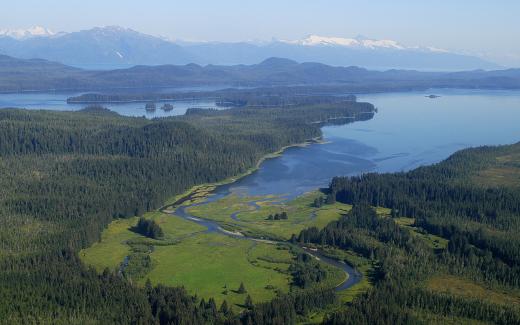Photo by John Schoen
By Chris Wood
The state of Alaska’s recent proposal to re-open the roadless debate brought back memories.
Mike was flossing his teeth when I entered his office. “I’m sorry. I’m running late for the dentist.” It was 1998, and Mike Dombeck, the chief of the U.S. Forest Service, had proposed a very controversial 18-month moratorium on new road construction into our national forests. The rationale for the moratorium was a backlog of more than $8 billion on maintenance of the existing road system. Many, including me, wanted to make the focus less about roads and more about the need to protect the areas without them.
Mike put the floss down as I made my pitch.
“I agree,” he said. “Let’s see what others think.”
On July 1, 1998, the 100th anniversary of Gifford Pinchot’s first day on the job as a Forest Service employee, Mike sent a letter to all Forest Service employees telegraphing his intent.
“We need to do a better job talking about, and managing for, the values that are so important to so many people. Values such as wilderness and roadless areas, clean water, protection of rare species, old growth forests, naturalness—these are the reasons most Americans cherish their public lands.”
After more than 600 public meetings and more than 1.6 million comments, the Roadless Area Conservation Rule was finalized in 2001. It protected from new roads about 58.5 million acres of wilderness-quality lands that comprise some of the finest fish and wildlife habitat and hunting and angling opportunity on the planet. It would come at a cost less than two-tenths of one percent of the nation’s timber demand from national forests. Energy development, off road vehicle use, mining, and other uses of the national forests were essentially unaffected.
U.S. Sen. Larry Craig of Idaho claimed that the Forest Service was acting “outside the law.” Sen. Craig Thomas of Wyoming said, “The rule was the last gasp of a hostile Clinton agenda to drive people off their public lands.”
That a federal rule with such minor economic costs caused such an uproar demonstrates that debate over roadless areas is less about facts and more about values. And the ecological value of roadless areas is hard to overstate. Drinking water for some 60 million Americans flows across roadless lands. Native trout and salmon are particularly dependent on them. In Idaho, for example, 75 percent of the remaining habitat for chinook salmon and steelhead are found in roadless areas. In Colorado, more than 71 percent of the remaining habitat for Colorado River cutthroat trout is found in roadless lands.
The correlation between roadless areas and trout and salmon is particularly strong in southeast Alaska, home of the Tongass National Forest. The Tongass comprises 25 percent of the world’s remaining temperate rain forests. It is a veritable fish factory. Forty percent of all the salmon on the West Coast come from the Tongass. The reason? Intact roadless areas.
More than 70 percent of all the remaining habitat for all the Tongass’ trout, salmon and steelhead are found within the forest’s roadless areas. Given the importance of roadless areas to salmon and trout in the Tongass National Forest, it makes little sense that the state of Alaska is proposing to re-open the roadless rule.
Commercial and sport fishing for salmon from the Tongass National Forest produces more than $1 billion in annual economic impact. At the same time, building roads and logging in the Tongass costs taxpayers many times more than it generates in revenue.
More maddening still is that a new Tongass forest plan was just finished based on the unanimous recommendations of a years-long collaborative group. They proposed phasing out cutting old-growth trees and protecting roadless areas especially the 77 that are the most important to trout and salmon.
Development of our natural resources helped to make America great. In the last analysis, however, it is respect for our lands and waters—the sort of humility that allows roadless areas to persist—that will sustain our fisheries and allow us to endure.
Chris Wood is the president and CEO of Trout Unlimited. He lives in Washington, D.C., and works from TU’s national headquarters in Arlington, Va.





